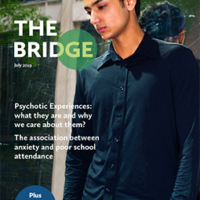Welcome to ‘The Bridge’. I would like to thank my colleague Dr. Mark Lovell for stepping in as Guest Editor over the last few months. He has been a star! I have been absent for a while as I have needed to look after my own child who has been unwell. Having spent a lot of time on a camp bed in a paediatric ward with young people and their families, some of whom were inpatients for weeks on end and facing huge physical challenges, it has made me wonder a great deal about the elements of psychological resilience in young people. This is a theme for this edition.
Healy et al. report that psychotic symptoms are surprisingly common in children (17%) and adolescents (8%). Their research suggests there is a strong relationship between self-esteem and psychotic experiences and that good self-esteem may be a potentially modifiable resilience factor. Kelly et al. highlight that resilience is “the ability of young people to cope and effectively adapt to life’s stresses and challenges”. Parents see resilience development in their young people as signifying mental health recovery. Healy et al’s study explores what facilitates this process, and they go on to propose “a theory of youth mental health recovery”.
Finning et al. have undertaken a systematic review to explore the relationship between school absence and anxiety symptoms. They highlight that school plays a key role in children’s development, and that poor attendance is associated with a range of adverse outcomes. Given how commonly we see young people with anxiety-related school refusal in clinical practice, I was surprised to learn that there is a lack of high-quality research in this area. The authors remain unsure if there is a causal relationship between anxiety and school absence. More research is needed in this area and in understanding the resilience factors that help young people overcome these difficulties.
I often meet young people who are approaching 18 and in transition and who have coped remarkably with significant psychosocial adversity and mental health challenges. Price et al. have undertaken a systematic review of qualitative studies of the experience of transition for young people who have a diagnosis of ADHD. Two-thirds of young people with this condition continue to experience significant symptoms in adult life that can cause disability in a variety of ways, and yet transition from child to adult services continues to present a major challenge for young people, their families and the clinicians supporting them. Difference in thresholds is a factor that impedes transition and Price et al. highlight that “the lack of healthcare resource and provision for Adult ADHD in the UK had a direct impact on the availability and quality of care for young people with ADHD, leaving them feeling abandoned and unsure how to manage the problems they experience”. It is difficult for young people with ADHD to be resilient if they cannot easily access the medication that helps them to do this, post 18 years.
Clearly, appropriate commissioning is important here and as CAMHS clinicians we have an advocacy role for the young people leaving our service. I do hope you find this edition interesting and helpful.
I hope you enjoy reading this edition of The Bridge please share it with colleagues, and a pdf version is available to download from the sidebar.
